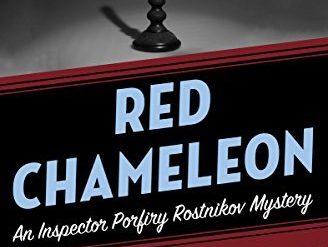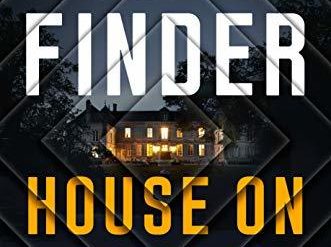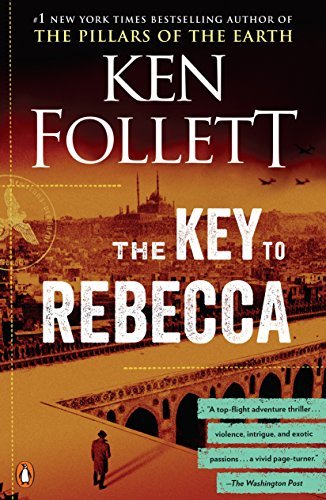
Estimated reading time: 6 minutes
Espionage fiction offers us a rich array of smoothly written and suspenseful novels set during World War II or in the Cold War era that followed. The classic work of Graham Greene (1904-91), Eric Ambler (1909-98), John le Carré (1931-2020), and Ken Follett (1949-), although written decades ago, holds up to the best produced by such contemporary masters of the genre as Joseph Kanon (1946-), Alan Furst (1941-), David Ignatius (1950-), and Paul Vidich. Two of Ken Follett’s novels offer special rewards for anyone with a taste for World War II spy stories. The better-known of those books is The Eye of the Needle, published in 1978. But in some ways The Key to Rebecca, which appeared two years later, may provide an even richer reading experience.
British cat, Nazi mouse—but the mouse is brilliant and ruthless
Most of the espionage novels that revolve around World World War II are set in Europe. The Key to Rebecca departs from the pattern. The story pits a clever and resourceful Nazi spy against a determined British counterintelligence officer. The Nazi, Alexander Wolff, was dispatched to his hometown of Cairo by General Erwin Rommel to help him clear the way to victory in North Africa. But Major William Vandam lucks on information about Wolff’s arrival in Egypt from an observant British officer and sets out to pursue him despite foot-dragging and interference from his commanding officer. The chase unfolds with nerve-wracking tension.
The Key to Rebecca by Ken Follett (1980) 400 pages ★★★★★
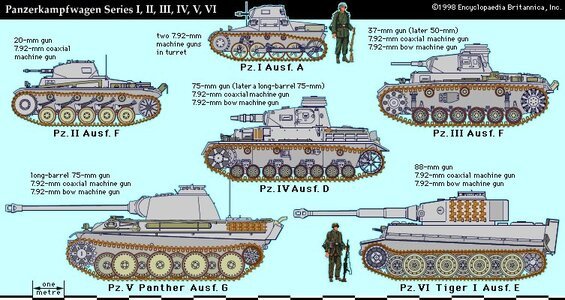
A simple tale with three leading characters
Once Alex Wolff has made his way back into Cairo, he sets out in search of a way to obtain top-secret military information from British GHQ Middle East (General Headquarters). His way is eased because he is bilingual—a German boy raised in Cairo in the home of an Arab stepfather. And he is adept at disguises. With the help of local contacts, he succeeds in short order, and the impact on the battlefield is dramatic. Rommel himself later proclaimed, “Our spy in Cairo is the greatest hero of them all.”
Meanwhile, a small group of Egyptian officers (including two future presidents, Anwar el-Sadat and Gamal Abdel Nasser), schemes to hook up with Rommel to throw out the British. Major Vandam is on Wolff’s trail. When a young Jewish-Egyptian woman who uses the name Elene Fontana joins Vandam on the hunt, and the Egyptian revolutionaries become involved as well, the story begins rushing toward a climactic end. Follett’s nimble prose and masterful handling of plotting make this one of the very best World War II spy stories.
The historical setting
The action in The Key to Rebecca takes place in the summer of 1942. It’s several months before the British-American landings in Algeria and Morocco that presaged the Allied victory in North Africa 1943. Rommel’s German and Italian forces were wreaking havoc on the British, pushing ever further into Egypt and threatening Cairo. Claude Auchinleck (1884-1981) commanded British forces in the region, with Neil Ritchie (1897-1983) leading the British Eighth Army against Rommel. (Bernard Montgomery (1887-1976) had not yet replaced him.) Although the British consistently outnumbered the Germans and Italians in the region, Rommel continued to outwit them. His bold maneuvers struck time and again at the weakest spots in the British lines, suggesting that the Nazi general was benefiting from secret information supplied by a spy in Cairo. At any rate, that’s the conceit on which The Key to Rebecca is grounded.
What is the “key” to Rebecca?
This meaning of the novel’s title doesn’t become clear until much of the action has occurred. But it’s no spoiler to explain it here. Rebecca is the title of a novel by Daphne du Maurier published in 1938. It was a huge bestseller when it appeared and has never gone out of print. Alfred Hitchcock made a film of the story in 1940 following du Maurier’s play of the same name, and the movie won the Academy Award for Best Picture. (Netflix made a remake in 2020.)
Rebecca surfaces in Follett’s novel since the secret code Alex Wolff uses to communicate with Rommel’s headquarters is based on its text. Within Wolff’s copy of the novel is a single sheet of paper that includes instructions on how to encode a message by selecting pages, lines, and words located at specific positions in the book. To decode the message, Rommel’s intelligence staff could easily consult its own, identical copies both of the book and the code. Follett’s adroit handling of this plot device helps make the novel one of the best World War II spy stories ever written.
About the author
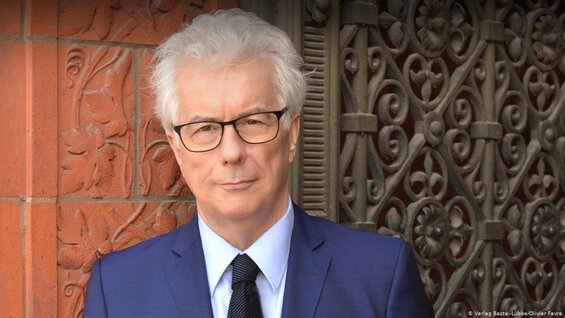
Ken Follett was born in 1949 in Cardiff, Wales. In a career spanning nearly five decades, he has written some of the most popular novels in the espionage genre, including at least two of the best World War II spy stories, as well as the monumental Kingsbridge Saga about the construction of a cathedral in medieval England. He has sold more than 160 million books. Follett is a prominent supporter of and fundraiser for the Labour Party.
For related reading
I’ve been reading Ken Follett’s work for decades. Since launching this blog in 2010, I’ve read and reviewed six of his other novels:
- The Eye of the Needle (Ken Follett’s classic WWII spy novel)
- The Evening and the Morning – Kingsbridge #1 (Ken Follett sets up the Kingsbridge Trilogy in a prequel)
- A Column of Fire – Kingsbridge #4 (Ken Follett’s 16th-century Kingsbridge saga: Christians killing Christians)
- Hornet Flight — The Danish Resistance and a secret Nazi base
- The Armor of Light – Kingsbridge Saga #5 (The Kingsbridge Saga moves to the Industrial Revolution)
- The Man from St. Petersburg (A terrorist threatens a WWI British alliance)
For other novels about espionage in the Middle East, see:
- Duet in Beirut by Mishka Ben-David—A failed Mossad operation threatens catastrophe
- Yesterday’s Spy by Tom Bradby—A gripping spy novel set amid an Iranian coup
- The Colonel’s Mistake (Mark Sava #1) by Dan Mayland—A spellbinding Middle Eastern spy story
- The Peacock and the Sparrow by I. S. Berry—The CIA and the Arab Spring
You might also enjoy my posts:
- 5 top nonfiction books about World War II
- The 10 best novels about World War II
- The 10 most consequential events of World War II
- The 10 top espionage novels
- 20 good nonfiction books about espionage
If you read historical spy thrillers, consider dipping into the work of these other excellent authors:
- Joseph Kanon’s spy thrillers are superb
- The evocative Night Soldiers series from Alan Furst
- The spellbinding thrillers of Robert Harris
- The Maisie Dobbs novels from Jacqueline Winspear
And you can always find my most popular reviews, and the most recent ones, on the Home Page.


